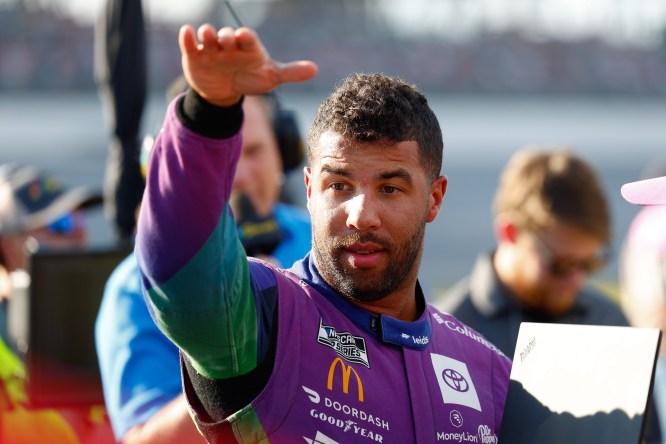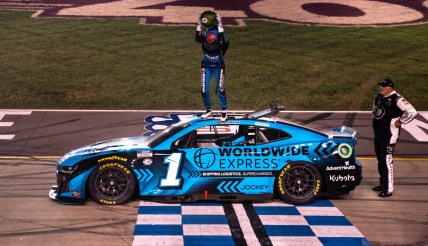This is a micro topic specific to the Toyota Racing Development teams on Sunday during the Cup Series race at Talladega but the conversation has some macro implications for the general state of superspeedway racing, too.
Is there a correlation between success and not being as beholden to manufacturer and team alliances come the end of the races at Talladega and Daytona International Speedway?
Ryan Blaney ultimately won the race, his third overall at NASCAR’s largest superspeedway, and he did it mano a mano without any considerations for the other Ford drivers and arguably at the expense of one in Kevin Harvick.
Granted, Harvick didn’t have anything to race for beyond the pride of ensuring his final season wouldn’t be a winless one but it wasn’t like there was a concerted effort to ensure that the Penske 12 won that race at all costs.
Sure, Riley Herbst in a Front Row Ford did a lot of the heavy lifting to get Blaney in position, but it never felt like a manufacturer order given the stakes for the 12 team in the playoffs. Once again in the mix for one of these races was Corey Lajoie, William Byron and Denny Hamlin, drivers who historically do well on superspeedways because of their general sense of selflessness when it comes down to it at the end of these races.
Hamlin said it at Talladega in the spring when talking about how that selfishness was a key.
“Being selfish was beneficial until NextGen, for sure, absolutely,” Hamlin said. “My independence and not wanting to work with teammates, not because I didn’t want to, but they made moves I didn’t necessarily agree with so I just would go rogue and go on my own.
“I just feel like this NextGen air in two-by-two racing, you can’t pull out and pass like you used to, by yourself so you have to rely on teammates. We’ve converted our style and I’ve had to change my style.”
That’s the focus of this story, how the NextGen or just the evolving state of affairs has changed the game, but especially for Toyota who faces a numbers deficit with just six cars until they are joined by Erik Jones and John Hunter Nemechek in the Legacy Motor Club cars next year.
Before the race on Sunday, during the drivers meeting, Hamlin said he spoke to five different drivers who he considered the best at this discipline historically and they all agreed that alliances have neutered their ability to excel at Daytona and Talladega.
Related: NASCAR Cup race at Talladega takeaways, including Ryan Blaney continuing to crush expectations
Bubba Wallace talks Toyota at Talladega

Bubba Wallace, who drives for Hamlin at 23XI Racing said after the race that their strategy and selflessness just buried all of them and prevented them from challenging for the win.
“We put ourselves behind working on a plan, and plans are great with teammates but they hurt us at the start and we got buried with track position and had to scratch and claw our way back to the top.,” Wallace said. “We got there by the final stage and gave it away on the final pit stop.”
Because the Toyotas are at a number’s deficit, they lost track position every time they pitted together, because they had just six cars to draft together where the other manufacturers had over a dozen cars each.
The margin of error is just thinner.
Wallace said he came over the radio and told crew chief Bootie Barker that literally everything they tried on Sunday wasn’t working.
“It goes back to the plan,” Wallace said. “We were trying to let Toyotas in, and if anyone at Joe Gibbs Racing and Toyota sees this, I’m all for it. It was just hurting us and pulling us backwards.
Related: Bubba Wallace responds to NASCAR doubters with Texas pole
“We were running 20th and we’re like, ‘hey get in line’ and that moved our line back every time. We just have to revamp it.”
Hamlin crossed the line fourth, and was eventually scored third with the post-race technical disqualification to Kevin Harvick, with no other TRD driver in the mix at the end of the race. Wallace said he felt bad for Tyler Reddick because he forced their group in a bad spot at the end of the race just trying to make something happen, together.
“I hate it for us and I hate it for (Reddick) because I told him before the restart, don’t lift,” Wallace said. “We should have just stayed in line until the last lap and it would have been a different outcome but we were too buried, unfortunately, to win the race.”
Reddick didn’t hold it against Wallace or the alliance, for what it’s worth.
“Our numbers are limited, right, so we need to work with each other,” Reddick said. “It’s helped way more times than it has hurt us.”
But Hamlin ‘just isn’t convinced manufacturers sticking with each other is the right move,’ in his opinion.
“I had those conversations in the drivers meeting and each of those drivers felt like they couldn’t show off their skulls as much in the NextGen because of the alliances and this that and the other,” Hamlin said. “It handcuffs drivers that are really special at doing this because you have to run behind whoever is in front of you.
“When you get down to the playoffs, most of the success I’ve had on superspeedways was just doing whatever I had to do for myself to win and we won a lot of races that way. But the early history of the NextGen has shown its mostly two-wide racing and you just can’t go on your own like you used to.”
Hamlin spent most of the middle to late stages of the race one lap down, but even then he spent it racing towards the front, at one point pushing Chris Buescher in a Ford to the front. He ultimately connected with Wallace and helped him get towards the leaders but then they coughed it up on the last pit stop.
“We did our best to help each other when we saw fit,” Hamlin said. “Certainly when I was up front battling for the lucky dog, I was doing my best to push Bubba because I knew all I was doing was racing (Austin Cindric for the lucky dog) so I was trying to keep him out front and us out front.”
At the end of the day, the Toyotas have just faced the number deficit and when they lost Christopher Bell briefly due to damaged sustained in a crash, combined with Hamlin losing a lap and Wallace trying to get stage points, it was just too chaotic to work together in any meaningful way.
“We struggle with numbers, right,” Hamlin said. “If you have one car drop back or another car on a different strategy because they had to fix damage, its just really tough. You need four or five cars in a line, really disciplined, to make lines work.
“Today, we saw more three or four wide racing and that was encouraging but it’s so hard to execute a plan, honestly. It really is because everyone is on a different agenda. The points I needed is different than the points the 23 needed.”
